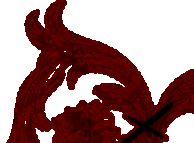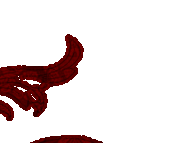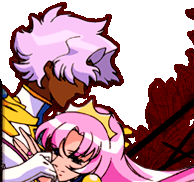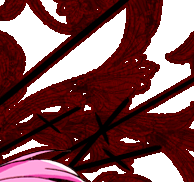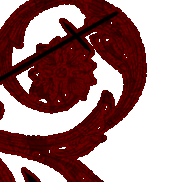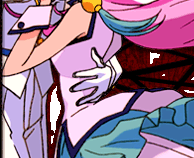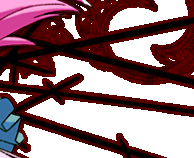
This analysis
was donated by Smash Genesis. (Link to Ao3!) 
The plot of the 1997 anime Revolutionary Girl Utena focuses on fourteen-year-old Utena Tenjou. Years ago, Utena’s parents died, and she was visited in her grief by a mysterious prince. The prince, impressed by Utena’s nobility, gifted her a ring with a rose crest on it, and Utena, impressed with the prince’s regal bearing, vowed to become a prince herself one day and save princesses. In the show’s present, Utena attends the prestigious Ohtori Academy, where she is drawn into a series of secretive, surreal swordfights waged over possession of her classmate, the demure but enigmatic Anthy Himemiya. Whoever wins the duels becomes Anthy’s fiancé and is promised the vaguely-defined “power to revolutionize the world.” Utena wins her first duel, and falls deeper and deeper into the lives of the duelists as she struggles to free Anthy from her role as a prize, believing that doing so will help her become a prince.
Revolutionary Girl Utena, while transgressive and brilliant, is undermined by its creators’ entrapment in the very systems it rails against: namely, patriarchy and gender roles. I submit that while the show’s message ultimately is not entirely nullified, the creative staff’s submersion in a patriarchal world does affect the series and must be weighed alongside the show’s message, which is a radical entreaty to mature beyond sexism and patriarchy. To support my claim, we will review material explaining the fabricated nature of gender, the concept of patriarchy, the meaning of entrapment, and finally, close readings of the show.
Patriarchy, as defined in Robert Bahlieda’s article “The Legacy of Patriarchy,” is a “system of practices, arrangements, and social relations that ensure biological reproduction, child rearing, and the reproduction of gendered subjectivity… the sense of gender identity itself.” (16) That is to say, patriarchy is a matrix which ensures that sperms and eggs come together to birth new babies and that the idea of men and women inalienable aspects of human identity continues to exist. Since this might seem benign, we must turn to Judith Butler’s book, Gender Trouble. In this book, they argue gender is “neither the causal result of sex nor as seemingly fixed as sex… If gender is the cultural meanings that the sexed body assumes, then a gender cannot be said to follow from a sex in any one way.” (10) That is to say, gender is not inherently baked into a person – it is a creation of the mind and of the society that mind engages with. From here, we can reasonably conclude that constraining people to constructed, gendered identities, even if supposedly for the sake of ensuring conception and childbirth, is a deleterious act that unnecessarily limits who people can be.
However, limits can only be pushed so far at a time. In his essay “Cultural Materialism, Othello, and the Politics of Plausibility,” Alan Sinfield writes: “Ideology is produced everywhere and all the time in the social order, but some institutions – by definition, those that usually corroborate the prevailing power arrangements – are vastly more powerful than others. The stories they endorse are more difficult to challenge, even to disbelieve.” (33) This means that ideas, tales, concepts, or what-have-you that support widely-accepted structures are harder to break free of than a story that upholds a weaker, less-prevalent system, a phenomenon he calls “entrapment.” We can see this in Revolutionary Girl Utena.
Series director Kunihiko Ikuhara explains in the interview, “Disturbing, Traversing, Borderless, Shaking Sexuality: The Place where Revolutionary Girl Utena was Born” that his intention with the show was to show a woman character discovering things that normally, only boys can have. This alludes to the idea of gender as something that can be transgressed. “Romantic,” he says, “has become a word for girls, and "romance" basically a word for men… So what I think is interesting is that while Utena is a woman, she is venturing into an essentially male ‘romance…’ I stipulated that until now, there had never been a girl venturing into the world, and through the stages of the story she becomes the first woman to discover ‘the end of the world.’” (Please note that as a loanword in Japanese, ロマンス or, in English, “romance” means something like an epic adventure.) Already, we can see Ikuhara’s desire to transcend boxes.
In the show’s symbological parlance, this idea of transcending boxes takes the form of breaking out of your coffin, and it is alluded to in much of the show’s imagery. As early as the first episode, we see from an aerial shot that the Ohtori Academy campus is shaped like a coffin. In episode 35, one of the duelists remarks, “We are all trapped in our coffins.” In episode 9 and again in the finale, we see that Anthy’s mind is literally trapped in a coffin. And most importantly, we can see at the end of the show that when Utena finally is able to reach Anthy emotionally, she does so by reaching down to Anthy and trying to pull her out of a coffin. Though Utena seems to fail, Anthy finally is inspired to stop being a prize for the duelists and to leave Ohtori Academy and the dueling game behind.
We can further extrapolate this to mean leaving gender roles behind for a plethora of reasons. Firstly, Anthy, when treated as a prize for the dueling game, is always referred to as the Rose Bride and wears an ornate, highly feminine red dress to each duel as she spectates. Utena is forced to wear a pink variation of this dress in the series finale, at which point she is referred to as a “princess.” This illuminates the show’s dichotomy of prince vs princess, which is itself inherently gendered, and is mercilessly torn down over the course of these 39 episodes. Secondly, the dueling game is revealed to be an elaborate ruse orchestrated by the school’s chairman, Akio, who despite offering the power to “revolutionize the world” to the duelists wishes simply to keep the dueling system in place. This relates back to what Bahlieda meant when he said patriarchy’s goal is to ensure the continuing of both childbirth and gender identity – the dueling game’s whole purpose is to pit the duelists against each other while promising them ultimate power but distracting them from figuring the truth, thereby perpetuating the cycle for the chairman’s sadistic amusement.
Although the notion of leaving patriarchy and gender roles behind overall is absolutely a positive message, we now must return to the concept of entrapment. The creators themselves are entrapped and still thinking with a patriarchal lens. In episode 29, fencing club captain Ruka Tsuchiya’s manipulations of his former friends Juri Arisugawa and Shiori Takatsuki continue after returning from the hospital in the previous episode. After his plan causes much pain for Juri and Shiori, he mysteriously vanishes.
While visiting a clubmate in the hospital, Juri overhears the Shadow Girls – quirky, omniscient figures who appear only in silhouette and commentate on the events of every episode – implying that Ruka has died of an illness he’d had the whole time. Ethereal music lends a melancholy tone to the scene and dusk lighting further adds to the air of tragedy. The Shadow Girls talk about how Ruka must have acted out of love. One says: “That reminds me. He used to say something a lot. He wanted to give the power to grant miracles to the one he loved. He wanted to free her from something.” That is, he was in love with Juri, and his end goal was to show Juri that the girl she is in love with – Shiori – is not worth her affection.
From there, the scene shifts to a large, black and white tile room that has appeared throughout the episode. Until now, it had three chairs arranged in a triangle. But now, one chair is gone, further cementing Ruka’s death. As Juri walks along a desolate path on campus, lined with barren trees, she has an inner monologue, ruminating on what she’d say to Ruka if she ever saw him again and thinking on what he’s done. The gentle, sad piano and string piece textures this episode-closing scene, painting Ruka in a disturbingly bittersweet light as Juri recovers from his abuse. (20:11-20:38) All this, despite the fact that Ruka earlier in the episode pinned Juri against a wall and forced her to kiss him, purposefully drove Shiori into a depressive breakdown, and threatened to destroy Juri’s most prized possession, her locket, reveals to us a desire on the show’s creators’ part to invoke some sympathy on the audience’s part towards Ruka. This in turn demonstrates an unsettling belief on the creators’ part – that abusing and manipulating women is “okay” if it is done out of love or to save them.
We can further see this misogynistic bias in favor of Ruka’s character in an interview with that particular episode’s director, Mamoru Hosoda. (Hosoda worked on the show pseudonymously as Katsuyo Hashimoto.) The interview, printed in the book The Art of Utena, contains the following excerpt:
“Hashimoto: Yes. In episode 7 Juri got considerably cornered, so I was wondering what kind of a man would it have to be to save such(sic) Juri… I thought that he has to be a pretty “extreme” kind of guy, otherwise it wouldn’t be possible for Juri to be saved. And in the end I thought that it has to be someone who can completely sacrifice himself without any ulterior motives behind his desire of saving other person.
- So, Hashimoto-san, it can be said without exaggeration that your image of Ruka is the person who saves Juri…
Hashimoto: That’s right… I think that since he cornered the very person he is in love with to such an extent it must have caused him a considerable amount of pain.”
We can see an enormous amount misogynistic condescension towards Juri in this passage alone. Firstly, he presumes that Juri needs someone else to save her from her own fruitless attraction. Hosoda does not think she is capable of growing up and moving on by herself. Secondly, he assumes it is acceptable for Ruka to intervene in Juri’s life because he is in love with her, even as he causes her so much pain, and thirdly, he speaks of Ruka with enough sympathy as to be concerning.
Another instance in which we can see this misogynistic bias is the case of Tatsuya Kazami. In episode 19, he attempts to ask out his friend Wakaba, only for her to reject him. He seeks the help of the school therapist, though unbeknownst to Tatsuya, this counsler, Souji Mikage, is seeking jealous, insecure souls to brainwash for his own ends. Tatsuya enters an elevator where he talks to Mikage and Mikage encourages him to indulge in his worst impulses, thus making him easier to brainwash. In a scene repeated throughout the arc with each patient, eerie music plays as the elevator descends, creaking all the way. A picture of a butterfly is shown hanging on the elevator wall, changing from a butterfly to a cocoon to a leaf between shots. This sets an unsettling scene, one that symbolizes the patients’ descent into madness. Finally, the elevator halts, and the patient is brainwashed, having been reduced to their most immature state.
Tatsuya is the only exception to this rule. Tatsuya talks about how Wakaba is too innocent to date other people and how only he can have her but instead of being brainwashed, the elevator actually starts ascending midway through the mock-therapy session, and the butterfly does not change. Finally, Tatusya cries in anguish: “WHY AM I NO GOOD!?” The elevator slams to a halt with a smash cut to black and the music cuts out. When the lights come back on, sanding behind Tatsuya is Mikage himself, seemingly having arrived by magic. Mikage coldly looks down at Tatsuya and says, “You are a truly good person.” Then, he tells him to get out. (19:23-21:11)
The question here, of course, would be why? Why does Mikage call Tatsuya a good person after hearing him wax condescension and entitlement about his crush? One could argue that being a villain, Mikage’s sense of morality is out of balance, and therefore we are not meant to agree with him. I subscribe to a simpler theory: the writers really do believe Tatsuya is a good person. The supporting evidence for this is that Tatsuya’s story ends there. He appears again briefly in episode 30, but otherwise, he never shows up again, and he certainly never gets a focus episode. We, the audience are left with simply: “You are a truly good person.” This, describing a boy who thinks that his crush is simply going to get take advantage of by other people, without ever thinking that perhaps if Wakaba’s that innocent, he shouldn’t go out with her, either: a glaring oversight both by Tatsuya, and the writing team.
To conclude, Revolutionary Girl Utena is a show that attempts to grapple with gender norms and the idea of being constrained on a societal level. Although it largely succeeds, the show shoots itself in the metaphorical foot on several key occasions. We, as an audience, must engage with the show while keeping these failures in mind, for it will deepen our appreciation of the show and will help us soar where it sank.
 Bibliography
Butler, J. (1989). Subjects of Sex/Gender/Desire. In Gender trouble: Feminism and the subversion of identity. New York: Routledge.
Hosoda, M. (1999). REVOLUTIONARY GIRL UTENA - INTERVIEW WITH HASHIMOTO KATSUYO (1115025869 842415318 G., Trans.). In Art of Utena: Shōjo kakumei Utena. Tōkyō: Bijutsu Shuppansha. doi:December 8th 2020
Hosoda, M. (n.d.). Revolutionary Girl Utena [Cartoon]. Retrieved December 12, 2020, from https://www.youtube.com/watch?v=_t6zrTOkw68
Ikuhara, K. (n.d.). Revolutionary Girl Utena [Cartoon]. Retrieved December 16, 2020, from https://www.youtube.com/watch?v=2RW5-UyuXQs
Kotani, M., & Ikuhara, K. (2000). Disturbing, Traversing, Borderless, Shaking Sexuality: The Place where Revolutionary Girl Utena was Born (1112353484 840679743 Y., Trans.). Actual Sexuality, (115). doi:December 7th, 2020
Sinfield, A. (1992). Faultlines: Cultural materialism and the politics of dissident reading. Bekeley: University of California Press.
 |

